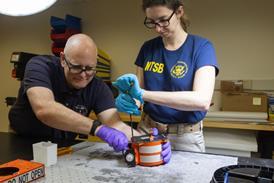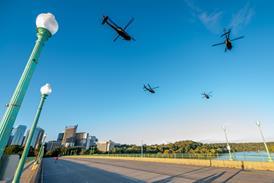Tim Furniss/WASHINGTON DC
A NEW ERA IN Martian exploration will begin in December 1996, when a McDonnell Douglas Delta 2 booster will launch the Mars Pathfinder, to blaze a fresh trail to the Red Planet. It will be the first of a series of missions, which are planned to be attempted every 26 months, possibly culminating in a return of Martian dust to the Earth in 2005.
On 4 July 1997, the Mars Pathfinder is scheduled to make the first Martian landing since that of the Viking 2 in September 1976, at 19.5¡N/32.8¡W, in an area known as the Ares Vallis. Compared with the large and expensive Viking, however, the Pathfinder will be a space dwarf, paving the way for cost-effective future planetary flights.
It is part of NASA's new way of doing things - smaller, faster, better and cheaper. The Mars Pathfinder will cost $270 million, less than 10% of the Viking programme, and will make a rather unsophisticated landing, bouncing across the surface inside inflated airbags. If the Pathfinder makes it, the first Mars rover, the Sojourner will be deployed. The Sojourner, weighing 11.5kg on Earth, is the size of a microwave oven.
The Mars Pathfinder was to have been the first in a network of Mars environmental survey (Mesur) landers as part of a new, low-cost, Discovery programme. The Mesur network was cancelled, but the Mesur Pathfinder, as it was then called, was retained as the first Discovery programme mission.
Protected by a conical heat shield, the spacecraft will hit the Martian atmosphere at 7.6km/s at an approach angle of 14.2¡, reaching peak 25g shock at 32km altitude. A parachute will be deployed when the craft has slowed to Mach 2 at 10km altitude. The heat shield and parachute will be severed and carried away from the landing area, as the Mars Pathfinder, enclosed in its airbags, hits the surface at 32km/s and bounces across the terrain for as long as 2min.
With the balloons deployed, the lander will expose three petal-like solar panels to provide 16W of electricity. A small stereo-imaging colour camera mounted on a deployable mast, will provide the first surface pictures to be taken for 21 years. Multiple colour filters will help determine what minerals are on the surface. Small magnets will help determine the magnetic component of Martian dust.
Instruments, which began analysing the atmosphere during the descent, will continue to work on the surface.
A highly integrated, high-performance, commercially developed multi-tasking computer-avionics package will be evaluated. The small rover - called the Micro-rover Flight Experiment - equipped with an alpha/proton/X-ray spectrometer, will be deployed from one of the three solar panels, to evaluate technologies required for future missions.
It measures 630mm long and 480mm wide, with a height of 280mm. It has a ground clearance of 130mm. It will be an "intelligent" rover, with an ability to recognise hazards and go around them, as it heads towards targets identified from the lander's images. The Sojourner has its own flat solar panel at its top, and its bogie suspension will permit it to crawl over small rocks.
The 325kg lander is expected to have an endurance of about 30 days and the rover seven, but, just in case, the Sojourner rover will complete its science and technical experiments within four Martian days or sols, which are about the same length as those on Earth.
SECOND CRAFT IN ORBIT
While the Jet Propulsion Laboratory-built Mars Pathfinder is in operation, another spacecraft, the Lockheed Martin Mars Global Surveyor (MGS) will be orbiting the planet. The MGS will be launched by another Delta 2 a month earlier than the Mars Pathfinder, in November 1996. From polar orbit, the MGS will provide global maps and data on the distribution of minerals and will monitor the planet's magnetic field.
The 1,050kg spacecraft will arrive at Mars in September 1997, entering orbit with a conventional engine retro-burn. It will then make a series of aero-braking manoeuvres to enter its prescribed operational, 93¡ inclination, Sun-synchronous, 367km-circular orbit by January 1998. NASA hopes that it will operate until January 2000.
Aero-braking was demonstrated in the final days of the Magellan Venus orbiter. The craft dips repeatedly into the top of the atmosphere at orbital low-point. Atmospheric drag causes a reduction in speed and orbit, saving the amount of on-board propellant required.
The low-cost MGS will carry the equivalent of some of the experiments lost on the Lockheed Martin-built Mars Observer spacecraft - one of the last NASA mega-projects, costing about $800 million. This went out of control, after an explosive gas leak in the propulsion system, as it was preparing to enter Mars orbit in August 1993. The instruments include a magnetometer, electron reflecto-meter, laser altimeter, orbital camera, thermal-emission spacetrometer, relay radio system, and radio science instrument.
The MGS is the first mission of NASA's new Mars Surveyor programme. Because NASA cannot afford ambitious and expensive programmes, the cost-effective Mars Surveyor will be used to answer fundamental scientific questions about the planet, especially about its climate, the evolution of water in the past and its suitability for future life.
Next in line, a Mars Surveyor lander and orbiter are scheduled to be launched aboard NASA Med-Lite boosters in December 1998 and January 1999, respectively, followed by more landers in 2001, 2003 and 2005, and a further orbiter in 2003. These may act as data-relay stations for other international missions. The 1998/9 lander and orbiter will be built by Lockheed Martin and will weigh between 400kg and 500kg.
The Mars Surveyors will employ Mars Pathfinder technology, state-of-the-art microelectronics and lighter materials, to reduce size and volume. This will create a ripple effect in reducing end-to-end mission costs and enable the use of smaller launchers. "Later Mars Surveyors will be lighter and smaller as they evolve," says Peter Ulrich, chief of the Flight Programmes Branch of NASA's Solar System Exploration division.
The 1998 Mars Surveyor lander will be the first spacecraft sent to one of the poles (south) of Mars, where it is expected to settle on alternating layers of clean and dust-laden ice.
"These areas probably hold the key to understanding what appear to be quasi-periodic climate fluctuations on the planet," says Dr Wesley Huntress, associate administrator for space science at NASA. "The nature of the orbit of Mars makes this our only opportunity to send a mission to a pole during the next decade."
The 1998 Mars Surveyor orbiter will carry a 1kg advanced optical camera from Malin Space Science, San Diego, California, weighing 1/20th of the mass of the Malin-built Mars Observer spare camera, which is being carried on the MGS.
The wide-angle camera will acquire daily weather maps with a resolution down to about 1km, while a 40m-resolution medium-angle camera will study alterations on the surface caused by changes in atmospheric conditions and winds.
The orbiter will also carry an atmospheric instrument called the Pressure Modulator Infrared Radiometer (PMIRR) - which failed to get aboard the Mars Observer - to measure temperature profiles of the atmosphere and monitor its water vapour and dust content.
WIDE-ANGLE IMAGES
Malin Space is building a camera for the lander, which will take wide-angle images of the landscape 10s after its parachute has been deployed, at about 8km altitude, until its conventional rocket-assisted landing at a site which will be finally selected from high-resolution images taken by the MGS. The lander's images will provide a larger geographic context for local landforms around the landing zone and help the orbiter take images of the exact landing site.
After touchdown, the lander will power up its 16.7kg instrument, the Mars Volatile and Climate Surveyor, from the University of California. Another part of the payload is a mast-mounted meteorological package with sensors to record atmospheric pressure, temperature and winds.
A mast-mounted imager will take stereo images of the landscape and a 2m-long robot arm will be used to dig up and deliver surface samples to the Thermal and Evolved Gas Analyser, to determine their content of ice and frozen carbon dioxide. The robot arm is part of NASA's New Millennium initiative to validate the technology of hardware for future missions. A rover was considered for the mission, but eliminated.
MARS TOGETHER
The Russian Space Agency (RSA) may supply a science instrument for the lander, in addition to hardware, which the RSA is contributing to the orbiter's PMIRR instrument. Options for the lander include a laser-ranging device, which measures atmospheric haze and dust, or an electro-magnetic sounder, which would map soil-density variations and possible subsurface water.
A 1994 Russian Mars mission and an originally planned, 1996 mission with a Rover and French atmospheric balloons, were cancelled. A smaller-scale November 1996 mission by a 500kg craft could be launched to embed two penetrators 300mm into the surface and to land two small instruments. A planned 1998 mission with the balloons and a rover has been cancelled.
Russia planned to launch a large rover to Mars in 2001, but may now become more involved in the Mars Surveyor 2001 mission - which would carry a version of the Gamma Ray Spectrometer, which was flown originally on the Mars Observer.
An optional plan for the USA to supply a craft or instruments for a Russian effort launched on a Molniya booster collapsed when Russia baulked at offering the launch free of charge. "They might have dropped us off at the Martian moon Phobos and then continued an independent mission, but the discussions were very preliminary," says Ulrich.
Russian involvement in the NASA "Mars Together" initiative "...may upset our plans for evolved improvements to the Mars Surveyor", says Ulrich. Russia's Institute for Space Research admits that proposed Russian missions or contributions to NASA flights face "acute financial problems".
The 2003 launch-window opportunity could feature a US effort in co-operation with the European Space Agency, which has proposed a network of landers - like the cancelled Mesurs - called the Marsnet. This is among three projects, one of which will be selected in April 1996. A launch slot for a US spacecraft has been reserved as a contingency.
The 2005 Mars mission may involve a sample return. "It will be very ambitious and we can't do it without funding. We'll need to sell this one to the Administration," says Ulrich. It may require international co-operation, but it will still require a fraction of the cost of Viking. "We need to act soon, though," Ulrich says.
Source: Flight International























